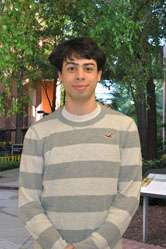Biochemistry
“Self-Consistency of Starting Motif in Sequence Scoring Motif Searching”

Transcriptional regulation is one of the primary methods through which organisms regulate protein synthesis. Transcription factors (TFs) carry out this regulation by binding to DNA, thereby enhancing (activators) or blocking (repressors) binding of RNA polymerase to gene promoter regions. DNA-binding proteins may bind to DNA nonspecifically or in a sequence and position-specific manner, but all transcription factors are unique in that they bind to a wide variety of specific sequences, collectively known as a binding motif. Computational methods allow us to calculate the probability distribution for TF binding over the entire genome of an organism. By utilizing different sequence scoring methods and biophysical models of binding, we extend this technique in order to assess the “self-consistency” of a binding motif. Starting with experimentally determined TF binding sites, we compute the binding probability distribution for the TF, and use this distribution to derive a new motif. We then iterate this expectation maximization process until convergence. Our results reveal that most TF-binding motifs are, to some degree, self-consistent. This finding provides a novel tool for analyzing TF-binding motifs, and a natural means for defining the essential components of a TF regulatory network, bringing us closer to understanding their roles in cellular decision-making.
How did you find your mentor for year research project?
I looked at the faculty research profiles on the Department of Biological Sciences website and found my mentor’s research description appealing, so I contacted him.
How did you know this was the project you wanted to do?
I took an interest in genomics and I felt that exploring scientific questions via computational methods would be a good fit for me as my schedule required more flexible lab hours and I had a strong background in computer programming.
Is this your first independent research project?
No, I had done research in the past at several other institutions.
How much time do you put into it? Do you get course credit for this work?
I put in from eight to 30 hours a week depending on the phase of the project. I receive credit through BIOL499.
How did you hear about the Undergraduate Research Award (URA) program?
I first heard about URAs at URCAD upon seeing so many of my peers that had been recipients and then sought out Ms. McGlynn to find out more about it.
What academic background did you have before you applied for the URA?
I had taken strong classes in biology, chemistry and computer science, as well as presented prior work from this lab at URCAD.
Was the application difficult to do? How much did your mentor help you with the application?
The application was quite straightforward and a good exercise in project planning. My mentor helped me develop a long-term plan and reviewed the language of the application.
What has been the hardest part about your research?
Learning about computational methods of hypothesis testing in contrast to the traditional methods employed in wet labs. I found it particularly challenging to understand the significance of a result in the context of the assumptions made in the theoretical framework of the computational models.
What was the most unexpected thing?
How easy it was to get started! Admittedly, it is a lot of work to learn the foundations, but with relative ease, one can begin answering biologically relevant questions with a minimal amount of effort and computational power.
How does your research relate to your work in other classes?
Certainly my genetics class more than anything else has been incredibly useful in understanding the background for my project, but in particular the mathematics and computer science courses have been invaluable in the implementation of the computational models.
What else are you involved in on campus?
I TA for the introductory biology course (BIOL141), write a science column for the Retriever Weekly and participate in the Undergraduate Admissions Ambassadors program.
What is your advice to other students about getting involved in research?
Meet with a lot of people! Ask your peers already involved with research, meet with your academic advisor, and then with the faculty in your department.
What are your career goals?
I hope to pursue a PhD in the area of neuroscience and/or genomics.
7/17/2013